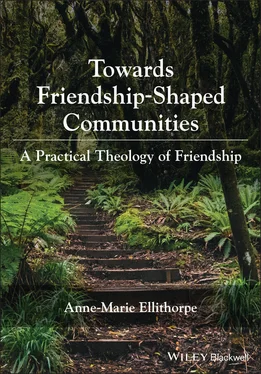For the purposes of this research, I draw primarily on Wenger’s use of practice. This definition’s integration of practical and theoretical, reality and ideal, gives it the versatility to capture nuances that may otherwise be missed, and lessens the need to continually specify that I am seeking out understandings as well as actions that contribute towards friendship. MacIntyre’s more specific definition and Dykstra and Bass’s theological nuancing of this definition in discussing practices also provide guidance. The criticism, retrieval, and strengthening of authentic friendship benefits from seeing things whole at several levels and from the integration of various practices with one another.
Another way in which a focus on practical wisdom is evident within this research is in the focus on understandings, and specifically on the social imaginary. Social imaginary is a term referring to the ways in which people envision their social existence. This includes how they relate with others, the expectations that are typically met, and the deeper normative images and ideas underlying these expectations. 34 The ways in which we imagine our social surroundings are often carried in stories, legends, and images, rather than in theoretical terms. 35 The imaginary is transmitted socially. It is also a vision “ of and for social life,” in that it draws on and creates a tacit understanding of what counts as human flourishing and as meaningful relationships. 36
For Charles Taylor, the term social imaginary includes a sense of the typical expectations people have of one another and the sort of common understandings that enable participants within a community to carry out the collective practices that make up their social life. 37 Within a specific social imaginary, certain practices make sense, while others do not and are excluded. Variations in the practice of friendship in various cultures may be attributed towards variations in the social imaginaries of these cultures, as well as to the inter-related dynamics of geographic and social mobility. 38
It is also possible that the social imaginary may be, or become, diseased. Indeed, as theologian Willie Jennings laments, although Christianity offers “a breathtakingly powerful way to imagine and act the social, to imagine and enact connection and belonging,” 39 much of Western Christianity “lives and moves within a diseased social imagination.” 40 A diseased social imaginary contributes to the perpetuation of imperialism, colonialism, racism, and sexism, and allows injustice to be perpetuated rather than addressed. While Jennings does not define social imagination , his use of this term is consistent with that of the social imaginary. Both terms point to the ways in which people envision their social existence.
The social imaginary draws on metaphors. New metaphors can reorganize our perceptions of the world and may implicitly call for transformation. 41 Further, the social imaginary may incorporate unrealized or partially realized ideals. For example, Taylor describes the Christian gospel as generating, during the Middle Ages, the idea of a community so inspired by love for God, others, and humankind that participants were “devoid of rivalry, mutual resentment, love of gain, ambition to rule, and the like.” 42 The expectation was that such a moral order was in the process of realization and would surely be fulfilled in the fullness of time. 43
While the term imaginary inherits a tendency towards“cultural abstraction,” 44 one may also speak of a social imaginary on a smaller scale, for example, a Benedictine, Presbyterian, or Pentecostal social imaginary. This term may also be used in a more person-centered manner, recognizing that learned cultural understandings are not necessarily a fixed entity fully held in common by a group. Rather, while groups may share some understandings, they may be fractured regarding other understandings. 45 Further, some understandings may be shared among those who have experienced similar “formative experiences despite living in different parts of the world” and lacking a common cultural identity. Thus, for example, a Chinese Australian Christian living in North America may share some cultural understandings with other Australian citizens, and some cultural understandings with other Asians, while being part of a Christian faith community will shape yet other understandings or imaginaries. The experience of living internationally is also likely over time to contribute to the reshaping of certain understandings.
The relationship between background understandings (imaginaries) and practices is reciprocal. While practices shape the imagination, the imagination also shapes practices. As Taylor notes, “a transformative understanding might enter a social imagination to unsettle and shift its ‘seeing’ of the way things are.” 46 Alternatively, changes to the imagination may be attributed to changes in practices. Indeed, Taylor notes that these may be inseparable. 47 With certain ideas being internal to specific practices, one cannot distinguish “Which causes which?” Shared imagination both sustains the meaning of practices and is sustained by practices. 48 Thus, the social imagination leads to specific practices of friendship, while simultaneously relational practices of friendship contribute towards the formation of the imagination.
Wenger likewise acknowledges the interplay between practices and imagination. While “the practices in which a group participates” form the collective imagination, the reverse also occurs, with the imagination giving meaning and telos to a community’s repertoire of actions, stories, and concepts. 49 Thus, over the course of time, imagination becomes embodied in a repertoire of practices, while these practices simultaneously shape the imagination. Repertoire is a way of “naming the patterns inscribed” in collaborative practices, thus defining the boundaries that form between the different communities of practice of which any given person is a part. 50
The use of social media provides a relevant example of the interplay between practice and imagination, with its implicit social imaginary fostering a self-focused configuration of one’s social world. As we uncritically inhabit such virtual worlds, there is a danger of being slowly and covertly drawn into “a body politic” which promotes shallow connections focused on self-gratification. 51
The relationship between social understandings and practices highlights the potential for a practical theology of friendship to inform the shared social and theological imaginary of Christian communities of faith, and the practices of friendship encouraged and nurtured therein. Tension arises between culturally informed and theologically informed social imaginaries when it comes to Christians and friendship. Contemporary Western cultures tend to value individualism, capitalism, consumerism, and mobility, and thus nurture contractual or competitive relationships, superficial attachments, and instrumental “friendships.” Friends are people we retreat to in our private relations; friendships tend to be private matters rather than being based in community. The sacramental and mystical dimensions of relationship are rarely recognized.
Christian leaders are aware of tensions as they seek to articulate, for example, the gospel’s call to simple living in contrast to the extremely strong pull of materialist ideology. Or they may preach about the body of Christ as they attempt to contend with the rampant individualism of the broader community that pervades the church community also. However, it seems that the tension between culturally informed and theologically informed social constructions regarding friendship may be particularly challenging to navigate. While the wider cultural milieu does not foster a deep understanding of friendship, neither does a great deal of theological education.
Читать дальше












